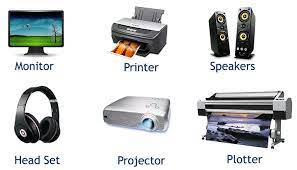Understanding Output Devices: Your Window to the Digital World

Introduction:
In the realm of modern computing, output devices play a crucial role in bridging the gap between the virtual world and our physical senses. They are the unsung heroes of the digital age, responsible for transforming streams of data into something tangible that we can see, hear, and touch. In this blog post, we’ll delve into the world of output devices, exploring their significance, types, and how they enhance our interaction with computers.
The Significance of Output Devices
Output devices are the gateway to the virtual realm created by computers. They provide a way for the computer to communicate with us, the users, by displaying, playing, or printing the information processed by the machine. Whether it’s a text document, a stunning image, immersive video, or a melodious song, output devices bring them all to life.
Types of Output Devices
There’s a diverse range of output devices, each tailored to convey information in different ways. Let’s explore some of the most common ones:

- Monitors:
- Monitors are the most familiar output devices, commonly used with desktops and laptops.
- They come in various types, such as LED, LCD, OLED, and CRT, offering a spectrum of display qualities from basic to ultra-high-definition.
- Speakers and Headphones:
- These devices are responsible for producing audio output.
- From simple built-in laptop speakers to high-end surround sound systems, speakers and headphones enhance our auditory experience.
- Printers:
- Printers generate physical copies of digital documents.
- There are inkjet, laser, and dot matrix printers, each with its own set of features and print quality.
- Projectors:
- Projectors are used to display large-scale images or videos on screens or walls.
- They’re ideal for presentations, home theaters, and classrooms.
- Plotters:
- Plotters are specialized output devices primarily used in design and engineering to create precise, high-quality drawings and schematics.
- Braille Displays:
- Braille displays are designed for visually impaired users, translating digital text into tactile Braille characters.
- Haptic Feedback Devices:
- These devices provide tactile feedback, such as vibrations or force feedback, to enhance the user’s sense of touch in gaming and virtual reality applications.
- E-readers:
- E-readers like the Kindle display digital books, offering a paper-like reading experience.
The Impact of Output Devices on User Experience
Output devices have a profound impact on user experience. The quality of the display, the fidelity of audio, and the precision of printed documents all contribute to our interaction with the digital world. Clear, vibrant visuals make images and videos come to life. High-quality audio immerses us in the world of sound. Precise printers ensure that documents are crisp and professional. Output devices enhance our connection to the digital universe.
Conclusion
In the ever-evolving landscape of technology, output devices continue to play a pivotal role in how we interact with computers and the digital world. They are the interpreters that transform streams of data into meaningful, human-readable formats. Whether it’s the crystal-clear monitor displaying your favorite movie, the high-fidelity headphones delivering your favorite song, or the printer producing important documents, output devices are the windows through which we connect with the vast digital universe. Understanding their significance and variety is crucial for a well-rounded appreciation of the technology that surrounds us.
Introduction
In the realm of modern computing, output devices play a crucial role in bridging the gap between the virtual world and our physical senses. They are the unsung heroes of the digital age, responsible for transforming streams of data into something tangible that we can see, hear, and touch. In this blog post, we’ll delve into the world of output devices, exploring their significance, types, and how they enhance our interaction with computers.
The Significance of Output Devices
Output devices are the gateway to the virtual realm created by computers. They provide a way for the computer to communicate with us, the users, by displaying, playing, or printing the information processed by the machine. Whether it’s a text document, a stunning image, immersive video, or a melodious song, output devices bring them all to life.
Types of Output Devices
There’s a diverse range of output devices, each tailored to convey information in different ways. Let’s explore some of the most common ones:
- Monitors:
- Monitors are the most familiar output devices, commonly used with desktops and laptops.
- They come in various types, such as LED, LCD, OLED, and CRT, offering a spectrum of display qualities from basic to ultra-high-definition.
- Speakers and Headphones:
- These devices are responsible for producing audio output.
- From simple built-in laptop speakers to high-end surround sound systems, speakers and headphones enhance our auditory experience.
- Printers:
- Printers generate physical copies of digital documents.
- There are inkjet, laser, and dot matrix printers, each with its own set of features and print quality.
- Projectors:
- Projectors are used to display large-scale images or videos on screens or walls.
- They’re ideal for presentations, home theaters, and classrooms.
- Plotters:
- Plotters are specialized output devices primarily used in design and engineering to create precise, high-quality drawings and schematics.
- Braille Displays:
- Braille displays are designed for visually impaired users, translating digital text into tactile Braille characters.
- Haptic Feedback Devices:
- These devices provide tactile feedback, such as vibrations or force feedback, to enhance the user’s sense of touch in gaming and virtual reality applications.
- E-readers:
- E-readers like the Kindle display digital books, offering a paper-like reading experience.
The Impact of Output Devices on User Experience
Output devices have a profound impact on user experience. The quality of the display, the fidelity of audio, and the precision of printed documents all contribute to our interaction with the digital world. Clear, vibrant visuals make images and videos come to life. High-quality audio immerses us in the world of sound. Precise printers ensure that documents are crisp and professional. Output devices enhance our connection to the digital universe.
Conclusion:
In the ever-evolving landscape of technology, output devices continue to play a pivotal role in how we interact with computers and the digital world. They are the interpreters that transform streams of data into meaningful, human-readable formats. Whether it’s the crystal-clear monitor displaying your favorite movie, the high-fidelity headphones delivering your favorite song, or the printer producing important documents, output devices are the windows through which we connect with the vast digital universe. Understanding their significance and variety is crucial for a well-rounded appreciation of the technology that surrounds us.


Leave a Reply